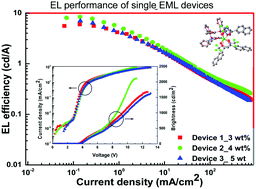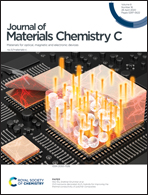Bright and efficient red emitting electroluminescent devices fabricated from ternary europium complexes†
Abstract
The photophysical properties of two previously synthesized, highly efficient, bright red emitting complexes [Eu(btfa)3DPEPO] (CIE, 0.672; 0.326) (Eu-1) and [Eu(nta)3DPEPO] (CIE, 0.673; 0.326) (Eu-2) (btfa = 4,4,4-trifluoro-1-phenyl-1,3-butanedione, nta = 4,4,4-trifluoro-1-(2-naphthyl)-1,3-butanedione and DPEPO = bis(2-(diphenylphosphino)phenyl)ether oxide) are reported. The complexes have been used as dopants to fabricate several single and double emitting layer (EML) electroluminescent (EL) devices. At the optimum doping concentration of 4 wt%, the single EML device of Eu-1 exhibited a pure red color with an external quantum efficiency (EQE) of 2.9% and a maximum brightness (B) = 1320 cd m−2, maximum current efficiency (ηc) = 4.08 cd A−1, maximum power efficiency (ηp) = 3.37 lm W−1 with a very low turn-on voltage (Vturn-on) = 3.8 V. Importantly, the single EML device of Eu-2 at the optimum doping concentration exhibited pure red EL with EQE of 6.0% with the best EL performance: B = 2108 cd m−2, ηc = 8.45 cd A−1, and ηp = 6.98 lm W−1 at a very low Vturn-on = 3.5 V. The performances of this device are among the best reported for devices incorporating a europium complex as a red emitter. Furthermore, the EL performances were achieved at the current density of 10 mA cm−2, thereby alleviating a serious efficiency roll-off as a major obstacle to the development of Eu-complex based EL devices.



 Please wait while we load your content...
Please wait while we load your content...